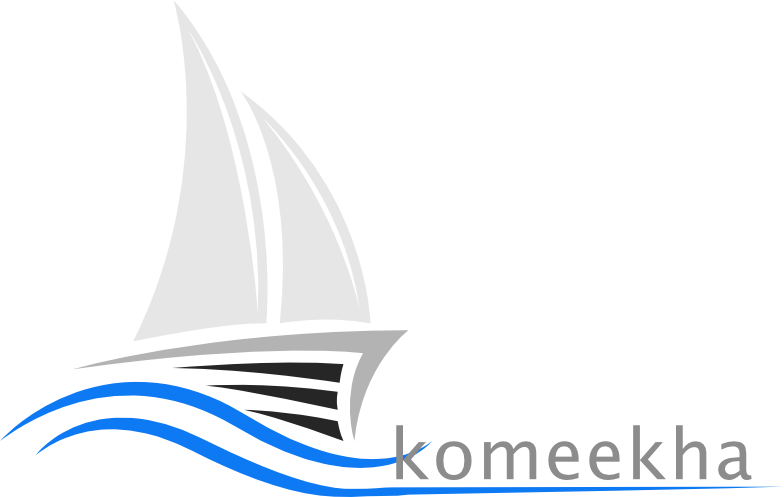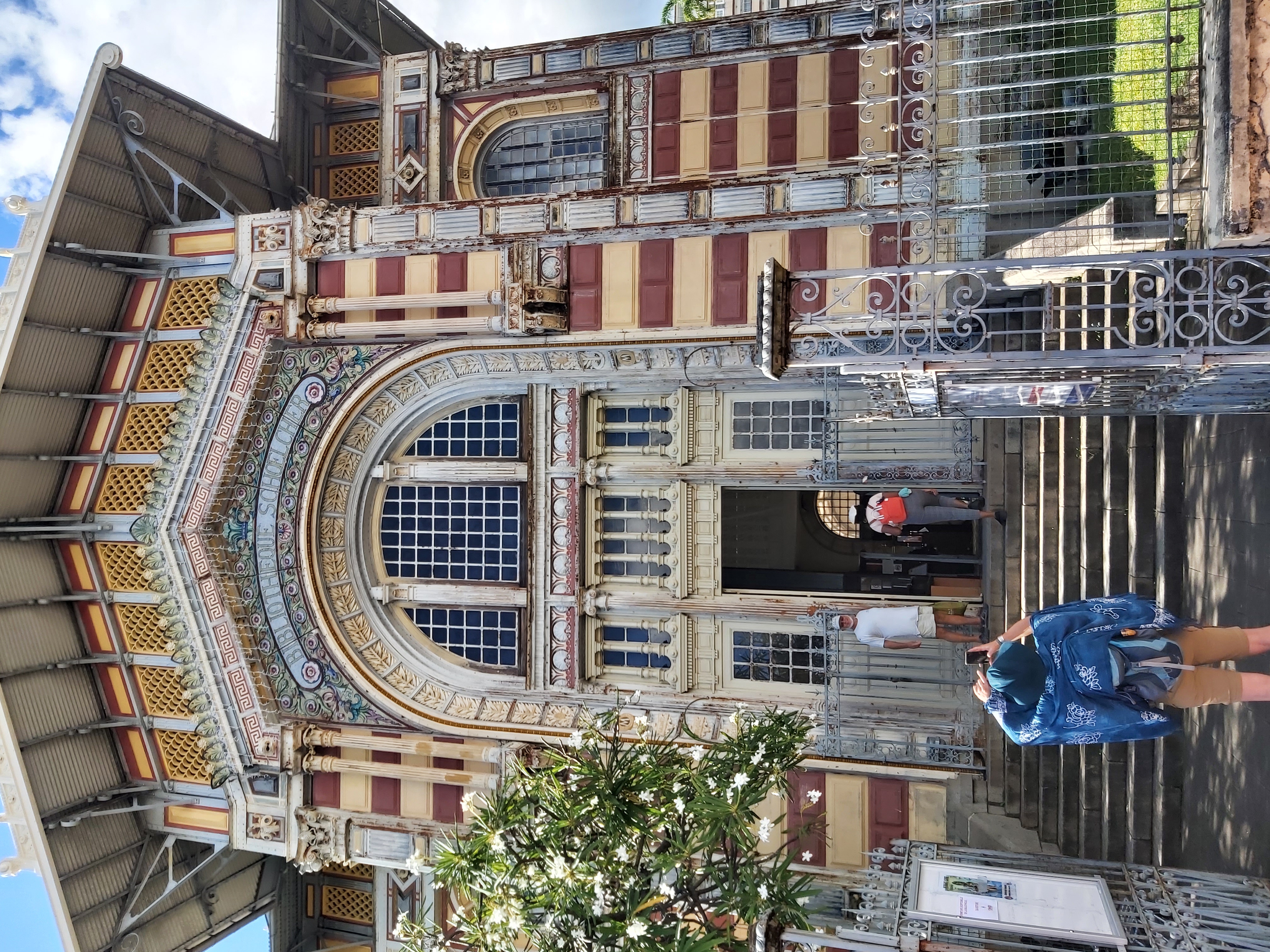I finished my previous blog with an upcoming mini-vacation: visit the East and North sections of Martinique by car.
February 11, our first day, was just a day trip: we came back to Komeekha to sleep. After picking up the car rental, we headed for Le Marin – the sailor’s mecca in Martinique – where sailors can find or order everything they need for their boats. We picked up our repaired genoa and boat parts. Frank loves shopping there; me ... meh ...
Our friends Jocelyn and Natalie (boat: Mordicus) joined us for the day. We started with the South East end of the island. Before I go further on our journey, let me explain what I’ve learned of the island geography during this mini-vacation. The East and the West shores are very different in many aspects. The water: The East shore faces the Atlantic ocean. This means winds are stronger, waves are bigger, and sargassum (floating seaweed) is rampant, clogging many beaches. The landscape: East is the shore that hurricanes hit first; so the landscape is wild, rough, and windswept. The views though are spectacular. The roads: From the main roads, to get to shores, we often had to drive for a long time in very narrow, steep, bumpy, barely paved and serpentine roads – a bit of a maze. By comparison, the West shore is more hospitable, lush, more populated; the roads are wider and better maintained. To me, East vs West is like two sisters. Even though they came from the same parents, they are very different. One is beautiful and gentle, easily approachable; the other one is plain and rough around the edges, but a hidden gem.
We covered the section from Anse Grosse Roche to Le Vauclin on that day. The four of us already new very well the Southern tip of the island, Les Salines. On the map, between Les Salines and Anse Grosse Roche the roads are so bumpy, sometimes just two dirt tracks, they became impassable for our rented car. We didn’t want to have a flat tire in the middle of nowhere!
Anse Grosse Roche is typical of my above description of the East shore. We walked a goat track on flat rocks, brush and cacti for a couple of kilometres. The wind was so strong, we could keep our hats on. LOL! At another beach, where we had lunch at a beach hut, we were entertained by kiteboarders and surfers having a grand time on the waves. The beach hut owner, after we paid our tab, didn’t want us to leave before we shared a nip of rum with him.
We visited Le Vauclin before heading back to Le Marin for dinner. Le Vauclin is a typical town: small streets, a few businesses and bakeries, a walking path and park along the shore. Le Vauclin, like many other towns, is preparing for the carnival (March 2-5): stores are displaying costumes and masks, public venues have some decorations. Talking about the carnival, back on Komeekha, we can hear music bands practicing during the evenings. For those of you who are new to reading these blogs, we experienced Martinique’s carnival a year ago. You can read the details on this website.
After a delicious dinner with Jocelyn and Natalie at Le Marin, we headed home to Komeekha, a 45-minute drive to Anse Mitan.
The following day, we covered from Le Francois, via Le Robert to Le Marigot. Again, little towns, bakeries and beaches. Last year, we had visited Trinite and Le Caravel presqu’ile; so we bypassed them. The views along the way are so beautiful; Frank had to be careful driving with his eyes on the road. We visited the Banana Museum. It was very interesting. Did you know that the banana plant (not a tree) is the biggest plant in the world? It can reach up to 18 feet. There are 80 kinds of edible bananas; and a lot more if you include the ones we can’t eat. We learned a lot about its history, its economic value in the Caribbean islands and in the world, everything you want to know about bananas. The museum included trails bordered by banana plants from many countries. A good visit. As we drove in the Northern part of the island, whole mountains sides have rows and rows of banana plants.
The following day, we drove up to the highest parking lot of Mount Pelee. Mount Pelee is a volcano at 1397 metres of altitude. From this parking, there is still a hard 8 km loop to the top. At this altitude, the wind is very strong and the temperature is cold. Hikers were wearing pants and sweatshirts, understandingly. Anyway, cutting this vacation story short, we saw a lot of interesting places; and, the Airbnbs were perfect.
We had a little adventure a few weeks ago that I’d like to share with you. We’re sailing from Anse Mitan to Saint-Pierre. There’s some wind but not enough to raise the main sail (the genoa was still at the repair shop). So this was an expected easy trip, only a couple of hours. We need to cross the Fort-de-France bay, which is deep, but has a small section where the sea bottom comes up to 50 feet. When the water is under about 100 feet, fishermen throw lobster/crab cages to the bottom with a small buoy to mark the location. These buoys could be colourful balls, or black ones (can’t see them at night), or simply a couple of empty and transparent water bottles. When there are waves, you can only see the colourful ones. So now, you see where I’m going with this, right? Yes, we sailed over one. Its rope wrapped around the propeller: clunk-que-clunk-que-clunk. Immediately, I put the engine in neutral. Komeekha started to derive with the wind on her side. Not being able to use the engine, we had to raise the main sail to move forward. Usually, a sailboat need to face the wind to raise the main; but with no propulsion we couldn’t turn the boat 90 degrees as required. So as Frank was working on deck with the sail and boom, I used the winch in the cockpit. After huge effort from both of us, we raise it half mast; enough to sail at 2 knots towards shore. Is the propeller broken? Will we need to be towed somewhere (ching ching, again)? Do we need to cancel our plans for the next week? These questions and many more were going through my mind at this point. When we found a quiet cove, Frank was able to dive and retrieve the culprit: a transparent plastic juice bottle still attached to an old algae-covered rope. Thankfully, the propeller was not damaged; and we could continue to Saint-Pierre. We were very lucky.
I’m now home in Owen Sound to have surgery on my arm this coming Monday. This surgery is required due to my fall last April 15th (see blog for more details). I flew from Martinique on the 18th, spent part of the night in the Montreal airport, met my sister Lucie the following morning at the Toronto airport, waited 3 hours for our transport to Owen Sound because of a major snowfall the previous night. OMG, so much snow here! We have walls of snow, above my head. My mailbox by the roadside is barely sticking out of the snow wall. The BBQ and raised fire pit on the back deck have disappeared. I have to hire a big snowblower to widen our driveway and parking area. The snow on roofs is at least 4-5 feet deep. At least, I found my winter clothes and boots which I haven’t worn for three years; and the Jeep started. We stocked the fridge, we have beers and wine. My son Justin and his family are coming for dinner tonight. All is well.
Now that I’m no longer sailing, I will not continue my blogs. However Frank, who continue sailing to Grenada, until March 31st, will write a few blogs along the way I’m sure.


